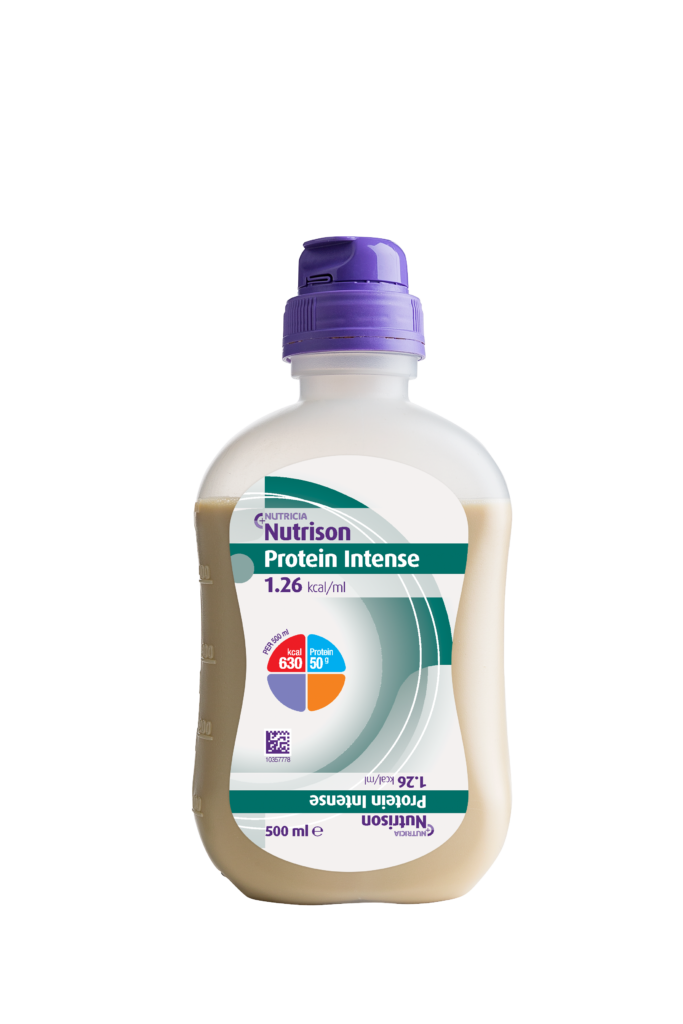
Product Information
A nutritionally complete, high, whole protein, ready-to-use, enteral tube feed.
Link copied!
Indications
For use in the dietary management of critically ill patients requiring high protein enteral feeding including burns, continuous renal replacement therapy (CRRT), obese & multi-trauma patients (as recommended by international guidelines1-4).
Important Notice
- Suitable as a sole source of nutrition
- Not for parenteral use.
- Not suitable for patients with galactosaemia.
- Not suitable for patients with cow’s milk protein allergy.
- Not suitable for infants under 1 year of age or children aged 1-12 years of age.
- Use with caution in children from 12 years and upward.
- Must be used under medical supervision.
- Use with caution in individuals with a seafood allergy.
Direction for Use
- Check appearance before use and shake well.
- Do not dilute or add medications to the formula.
- Use at room temperature.
- Handle aseptically to ensure product remains sterile.
- Usage to be determined by a healthcare professional.
Storage
- Store in a cool, dry place.
- Once opened, close the lid and store in a refrigerator.
- Discard unused contents after 24 hours.
Order Information
Contact Nutricia Customer Experience 1800 889 480
| Nutrison Protein Intense | Product Code | Units per carton |
| 500ml OpTri bottle | 141425 | 12 |
Ingredients
Full ingredients list and nutritional information is available on the product fact sheet.
Allergen & Cultural Information
- Contains: milk, soy and fish.
- Halal certified.
- Nutricia UK and/or Ireland have Kosher approval for this product.
- No gluten containing ingredients. No detectable gluten when tested to a sensitivity level of less than 5 parts per million (<5 ppm i.e. <5mg/kg).
- Low lactose (lactose <2g/100g).
References
- McClave SA, Taylor BE, Martindale RG, et al. Guidelines for the Provision and Assessment of Nutrition Support Therapy in the Adult Critically Ill Patient: Society of Critical Care Medicine (SCCM) and American Society for Parenteral and Enteral Nutrition (A.S.P.E.N.). Journal of Parenteral and Enteral Nutrition. 2016;40:159-211.
- Kreymann KG, Berger MM, Deutz NEP, et al. ESPEN Guidelines on Enteral Nutrition: Intensive care. Clin Nutr. 2006;25:210–223.
- Dhaliwal R, Cahill N, Lemieux M, et al. The Canadian Critical Care Nutrition Guidelines in 2013: An Update on Current Recommendations and Implementation Strategies. Nutrition in Clinical Practice. 2014;29:29-43.
- Sioson MS, Martindale R, Abayadeera A, et al. Nutrition therapy for critically ill patients across the Asia-Pacific and Middle East regions: A consensus statement. Clin Nutr ESPEN. 2018;24:156-164.
- van Zanten ARH, Petit L, De Waele J, et al. Very high intact-protein formula successfully provides protein intake according to nutritional recommendations in overweight critically ill patients: a double-blind randomized trial. Critical Care. 2018; 22:156-67.
- Hurt RT, McClave SA, Martindale RG, et al. Summary Points and Consensus Recommendations From the International Protein Summit. Nutrition in Clinical Practice. 2017;32:142S–151S.
- World Health Organization. Protein and amino acid requirements in human nutrition: report of a joint FAO/ WHO/UNU expert consultation. 2007; WHO technical report series ; no. 935.
- Kuyumcu S, Menne D, Curcic J, et al. Noncoagulating enteral formula can empty faster from the stomach: A double-blind, randomized crossover trial using magnetic resonance imaging. Journal of Parenteral and Enteral Nutrition. 2015;39:544-551.
- van den Braak CC, Klebach M, Abrahamse E, et al. A novel protein mixture containing vegetable proteins renders enteral nutrition products non-coagulating after in vitro gastric digestion. Clinical Nutrition. 2013;32:765-771.
- Klebach M, Hofman Z, Bluemel S, et al. Effect of protein type in enteral nutrition formulas on coagulation in the stomach in vivo: Post hoc analyses of a randomized controlled trial with MRI. Abstract presented at Clinical Nutrition Week, January 16–19; Austin, Tx. Journal of Parenteral and Enteral Nutrition. 2016;40:134(21).
- Luttikhold J, van Norren K, Rijna H, et al. Jejunal feeding is followed by a greater rise in plasma cholecystokinin, peptide YY, glucagon-like peptide 1, and glucagon-like peptide 2 concentrations compared with gastric feeding in vivo in humans: a randomized trial. Am J Clin Nutr. 2016;103:435–43.
- Abrahamse E, van der Lee S, van den Braak S, et al. Gastric non-coagulation of enteral tube feed yields faster gastric emptying of protein in a dynamic in vitro model. Abstract presented at 34th ESPEN Congress. Sept 8-11; Barcelona, Spain. Clinical Nutrition Supplements. 2012;7:PP239(119).
- Liu J, Klebach M, Abrahamse E, et al. Specific protein mixture reduces coagulation: An in vitro stomach model study mimicking a gastric condition in critically ill patients. Poster presented at 38th ESPEN Congress. 17- 20 September; Copenhagen, Denmark. Clinical Nutrition. 2016;35:MON-P182 (S220).
- Zadak Z, Kent-Smith L. Basics in clinical nutrition: Commercially prepared formulas.e-SPEN, the European e-Journal of Clinical Nutrition and Metabolism. 2009;4:e212-e215.
Additional Information
^ In accordance with Australia New Zealand Food Standards Code – Standard 2.9.5
